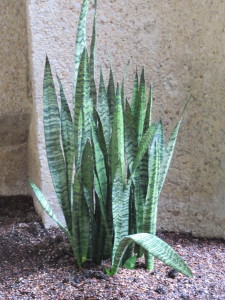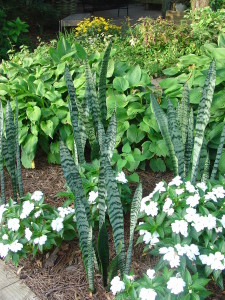Snake plant (Sansevieria spp.), aka Mother-In-Law’s Tongue, is an easy to grow succulent. It is one of the hardest house plants to kill, grows in almost any room of your home, and demands little attention except an occasional watering.
Its leathery sword-shape leaves are usually marked in gray green marbling. Some varieties may be edged in yellow or white. Plant varieties run from 6 inches to 4 feet in height and most are rosette form.
Snake plants tolerate low light, but grow better in bright light. They are not bothered when kept in a dark closet for 2-3 months. It grows well at room temperatures between 55 to 85 °F. Temperatures under 55 °F will mar some of the leaves. Rooms with low humidity don’t seem to bother plants. Misting foliage is unnecessary.
Water pots every 7 – 10 days thoroughly, allowing soil (potting media) to dry in between waterings. If leaves start to droop or the plant base begins to rot, you’re probably watering too much. If leaves appear wrinkled, you’re not watering enough. During the autumn and winter, reduce watering frequency to 2-3 times monthly. Prevent water from collecting in the tubular center of the plant.
Snake plants thrive outdoors in a shaded garden under a large shade tree in bright light. Add to containers with shade annuals and perennials. Plants grow vigorously and foliage coloration is more intense. Direct sun will burn the leaves of most varieties of Sansevierias.
Feed plants using a water soluble fertilizer such as Miracle-Gro® or Schultz® House Plant products. Use one-half the recommended package dose.
Repot snake plants every 12-18 months. If available, use a potting mix labeled for cacti and succulents, typically a blend of peat, bark, and coarse sand (or perlite).
White or cream colored lily-like flowers are highly fragrant and last 3-4 weeks. Flowers are attached to a long sturdy stalk and may be 3 feet high. What triggers flowering is unknown as it is a rare occurrence.
Poisonous!! Prevent pets and children from ingesting the foliage.



 Posted in
Posted in 
